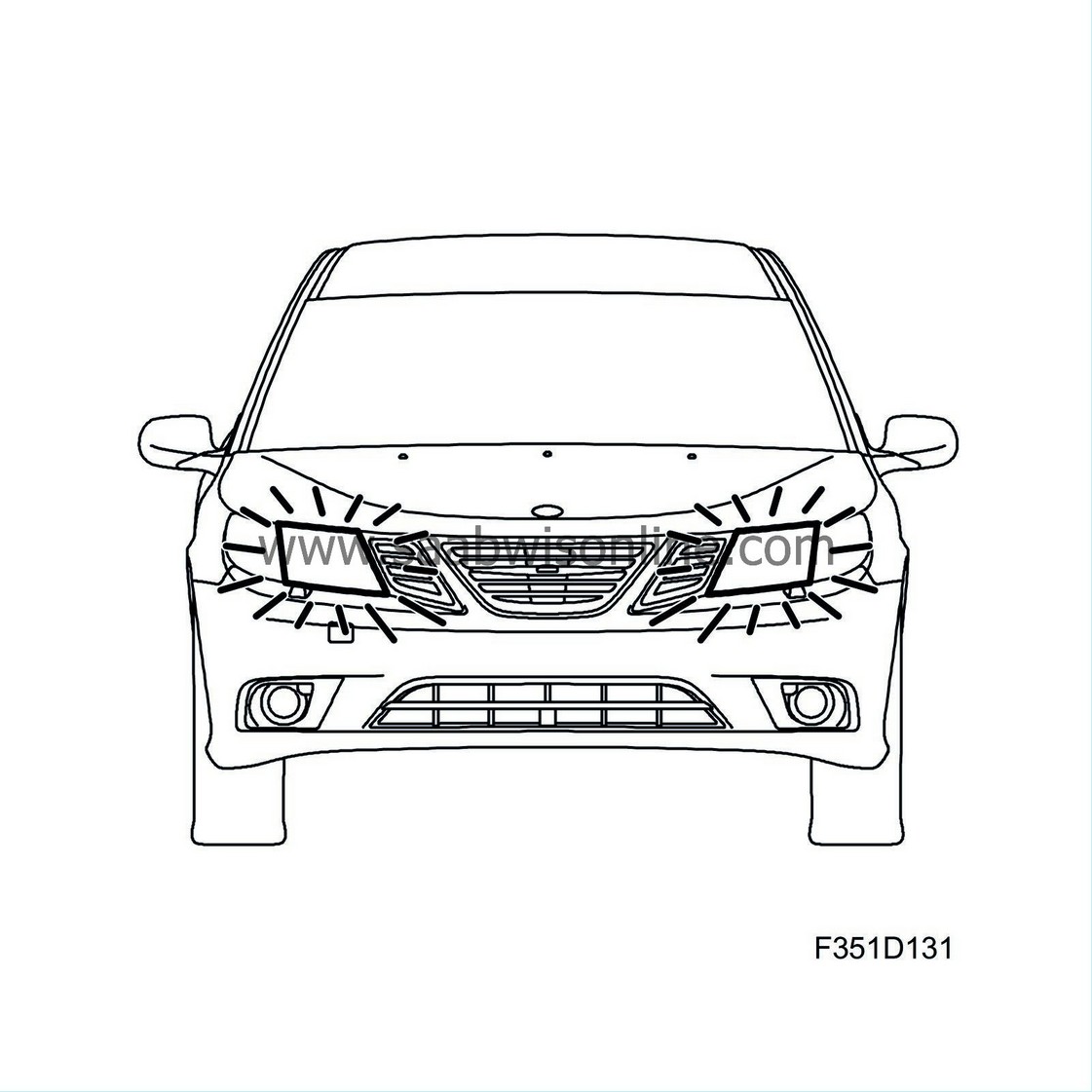PRE-RELEASE
Main lighting, detailed description
| Main lighting, detailed description |
Main and dipped beam, tail lights, number plate lighting and parking lights are part of the main lighting.

| Important | ||
|
When changing a bulb, use one with the right output otherwise the components could be damaged. |
||
UEC handles logic for the main lighting. The light switch (10) is connected to BCM (707), which sends out bus messages about the position of the switch.
The dipswitch (215) is connected to the Column Integration Module, CIM (703). CIM sends bus messages about the position of the switch. UEC uses these bus messages to activate main or dipped beam.
The headlamp flasher, a “main beam flash”, can be activated regardless of the position of the ignition switch and light switch by using the dipswitch (215) to the right of the steering wheel.
Main beam is operated with the dipswitch (215) and the light switch (10). The dipswitch controls main beam 2 different ways: main beam flash (stalk pulled to spring-back position) and main beam (stalk in a fixed position). Either way, the stalk is pulled towards the steering wheel rim.
For main beam to shine continuously, the light switch (10) must be in position 2.
On certain markets, dipped beam is used as daytime running lights. This depends on how UEC is programmed.
The US/CA/MX markets have automatic DRL. The light switch then has an "AUTO" position where the "0" position would normally be. When light conditions require such, a "DRL lamp" comes on in each headlamp (for cars with Bi-xenon) or dipped beam comes on at reduced brightness. Light conditions are detected via light-sensitive sensor integrated in the rain sensor.
Daytime Running Lights (DRL)
On certain markets, dipped beam is used as daytime running lights, which light automatically when the ignition is switched on.DRL can be adjusted (ON/OFF) using the diagnostic tool. If the value is set to ON, dipped beam will come on when the light switch (10) is in position 0. If the value is set to OFF, neither parking lights nor dipped beam will come on when the light switch (10) is in position 0.
| DRL | Light switch positions | ||
| 0 | 1 | 2 | |
| DRL OFF | No main lighting | Parking lights | Main and dipped beams |
| DRL ON | Parking lights and dipped beam | Parking lights and dipped beam | Main and dipped beams |
If main beam is on and the ignition is turned off, or if the light switch is turned to any other position, the main beam will be switched off and must be turned on again.
When the ignition is off, the same programming function applies to all markets. In position 0, no lights are lit. In position 1, parking lights are lit.
AUTO - Daytime Running Lights (DRL)
For the following markets: US/CA/MXDRL with reduced output to the dipped beam lamps (halogen) or with unique bulbs (Bi-xenon); the parking lights are not lit.
Two combination rain/light sensors are fitted in the windscreen and are connected to the rear electrical centre (REC). Dipped beam is activated automatically when exterior light conditions require such.
REC transmits a bus message with information on the light conditions. BCM reads the bus message. When the limit value is reached, BCM transmits a request for dipped beam activation. This bus message is used by UEC (to activate dipped beam and the position lights) and REC (to activate the rear parking lights).
The following conditions will cause DRL to come on if the ignition is "ON":
Automatic transmission: When the gear selector is moved from "P".
Manual gearbox: Immediately if the handbrake is not applied. If the handbrake is applied, DRL comes on when the handbrake is released.
Cars with halogen
UEC sends a PWM voltage to the dipped beam lamps (average voltage is 10.8 V). Pulse-width modulating the supply voltage increases the service life of the bulbs.
Cars with Bi-xenon
UEC sends B+ to the DRL lamps in the headlamps.
Halogen headlamps
Each headlamp contains an H7 (H11 for US/CA) halogen bulb with 70 mm lens for dipped beam and an H9 (H7 for US/CA) bulb for main beam. The outer headlamp lens is plastic.When dipped beam is selected, only the H7 bulb for dipped beam (12) lights. When main beam is selected, both the dipped and the main beam lamps (11) light. If the output of the bulbs exceeds 100 W, a DTC is generated in UEC and an error message is displayed in SID.
Xenon headlamps
Each headlamp (663 FL/FR) contains a 35 W Xenon bulb (D1S) with a 70 mm lens for dipped and main beam, corresponding ballast and ignition transformer. There is also an H7 halogen bulb that is used for main beam. Xenon headlamp optics shift between dipped and main beam by means of a shutter that is lowered and raised. The outer headlamp lens is plastic. Cars with xenon headlamps are equipped with automatic headlamp levelling.When dipped beam is selected, only the xenon bulb for dipped beam (11a) lights. When main beam is selected, both the xenon and the main beam bulbs light. If the output of the halogen bulbs exceeds 100 W, a DTC is generated in UEC and an error message is displayed in SID.
Xenon headlamp, US/CA
Each headlamp (663 FL/FR) contains a 35 W Xenon bulb (D1S) with a 70 mm lens for dipped and main beam, corresponding ballast and ignition transformer. A separate bulb for DRL is fitted next to the bi-xenon optics. The outer headlamp lens is plastic. Cars with xenon headlamps are equipped with automatic headlamp levelling.For dipped beam, only the xenon bulb lights to provide dipped beam brightness. For main beam, full brightness is provided (11a).


